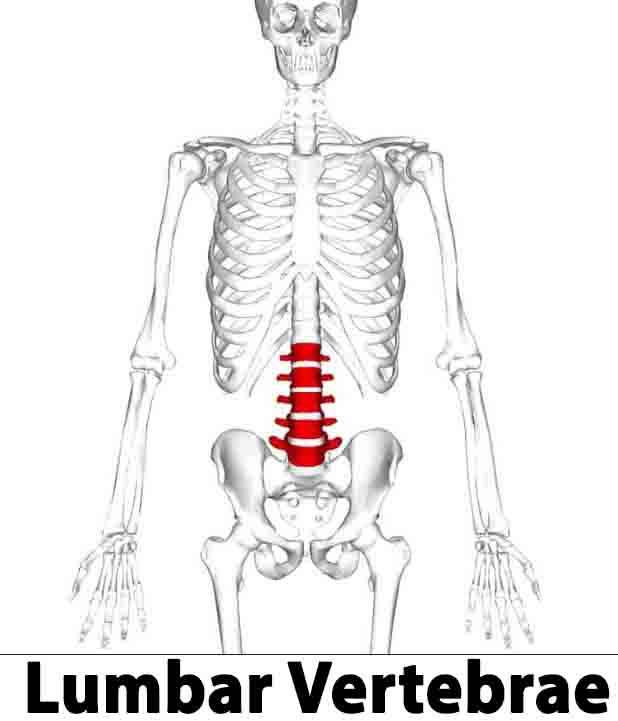Lumbar Vertebrae Definition
The lumbar vertebrae are bones that make up the spinal column or backbone, especially within the lower back. These bones are below the cervical and thoracic vertebrae but above the sacrum or pelvis.
These are the biggest of the unfused vertebrae, and are bigger than the bones positioned above. There are five lumbar vertebrae in humans, referred to as L1 through L5. L1 is closest to the thoracic vertebrae, whereas L5 is closer to the pelvis.
These can be recognised from the other vertebrae because they lack foramina in the transverse processes. They do not have ribs or facets to articulate with the ribs. They are located next to the thoracic vertebrae in humans, as well as cervical vertebrae in certain species—such as lizards. These bones give a concave curvature to the lower back.
Lumbar Vertebrae Function
The lumbar vertebrae’s job is to sustain the vast weight of the body and facilitate specific activities, such as lifting items. The lumbar vertebrae flex and stretch by rotation between the vertebrae and movements in the sagittal plane between them.
Animals with fewer lumbar vertebrae—such as gorillas and chimpanzees—tend to lack the capacity to curve their lumbar spines as compared to humans.
These bones help shield the spinal cord and nerves from damage and offer a degree of support. The lumbar vertebrae are the largest vertebral bones. They expand in size lower down the spine in order to sustain the increasing weight of the body.
Lumbar Vertebrae Structure
The lumbar vertebrae have a central body, often known as the centrum. This is huge and usually flattened, and it supports most of the body’s weight. The body is generally kidney-shaped in most animals and is formed of a cancellous bone centre, with a cortical bone shell surrounding the exterior.
The body has a concave form where the intervertebral discs are placed. They are fibrous connective tissue discs. The outer layer is known as the annulus fibrosus and enables a modest degree of mobility and maintains the vertebrae in place. The inner layer—the nucleus pulposus—is gel-like and absorbs stress between the vertebrae to lessen strain put on the lower back.
The pedicles assist construct the vertebral arch and are strong bones directed rearward from the body. They feature strong, short laminae that make up part of the arch. The laminae grow shorter and broader as the vertebrae move down.
The arch forms a triangular vertebral foramen in each of the vertebrae, which is bigger than the foramen seen in the thoracic vertebrae but not as large as that of the cervical vertebrae. This foramen permits the spinal cord, meninges, and cauda equina to pass through.
The lumbar vertebrae have processes comparable to those of the other vertebrae. They feature a thick, wide spinous process with sets of articular processes that protrude between the pedicles and laminae. The transverse processes are long, thin, bony projections. They are comparable to the ribs found in the thoracic vertebrae but are shorter and smaller.
In the lower lumbar vertebrae, there are three tubercles present: the costiform process, mammillary process, and accessory process. The bony processes of the lumbar vertebrae offer muscular attachment places, such as for the psoas major and multifidus muscles.
L5 has a somewhat different form than the other lumbar vertebrae. It has a body that is larger in the front, unlike the others where the body is deeper in the back half of the centrum. It also has a smaller spinous process, with thicker transverse processes which might emerge from the pedicles or the body. The spinous process has a four-sided form and comes to a thick notch.
Why is it Important
L5 is a frequent location of spondylolisthesis and spondylolysis. Spondylolisthesis is forward displacement of the vertebra as compared to the bone below it. Spondylolysis is a stress fracture or defect in the vertebral arch, which tends to appear asymptomatically in most individuals. People with fewer or more lumbar vertebrae often have the final lumbar bone damaged with these illnesses.
A range of illnesses can affect the lumbar vertebrae, comparable to those impact the other vertebrae. Disc herniation is possible, and can place pressure on the spinal cord and cauda equina. Fractures, ligamentous injuries, and muscular strains are also conceivable with the lower back. Muscular injuries are very prevalent, considering the fact that the lumbar spine carries a considerable percentage of the body’s weight.
In addition, inflammatory illnesses like spondylitis, rheumatoid arthritis, and psoriatic arthritis might arise. Tumors or cancer can arise inside the lumbar spine, mainly related to carcinomas. Infections inside the bone, spinal cord, or meninges are conceivable, too.

